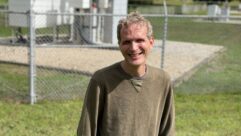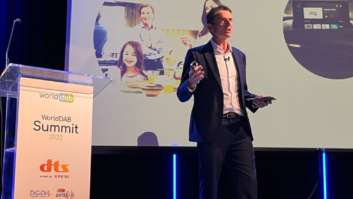AES Topics Include NRSC-5 Standard, Copy Protection and the ‘Low Bitrate Last Mile’
SAN FRANCISCO Radio interests were well represented at this fall’s Audio Engineering Society convention, with much of the buzz revolving around the potential for new services and technology to enhance the listening experience.
A panel session on the state of digital radio, a special event open to all attendees, highlighted how far the industry has come since the AES first presented a session on the topic 14 years ago.
The panelists tailored their remarks to a diverse audience of audio professionals, many of whom were learning about digital radio for the first time. Even so, the breadth of the presenters assembled by session organizer and moderator David Bialik, a systems engineering consultant, ensured that even broadcast engineering junkies came away with insights.
David Layer, director of advanced engineering for NAB Science and Technology, led off with an overview of the state of digital radio rules and standards.
At the FCC, Layer reported, attention is still focused on reviewing the comments and reply comments in response to the Further Notice of Proposed Rulemaking and Notice of Inquiry in MB Docket 99-325, issued in April.
This proceeding, as summarized by Layer, is intended to develop rules regarding conversion policy, audio quality requirements, datacasting, the multi-channel service known as Tomorrow Radio, subscription services, local programming requirements and AM operations.
In its own review of the comments and reply comments, Layer said, NAB detected a consensus on most of the big items being considered:
-
The adoption of IBOC needs to be a market-driven transition;
-
There needs to be flexibility for main channel audio quality;
-
There needs to be flexibility for new services (Tomorrow Radio and others); and
-
Dual-antenna implementations of FM IBOC should be allowed without STAs.
Some controversy remains, however, on nighttime AM IBOC operation and copy protection requirements, which may delay a final decision in the proceeding, according to Layer. Until the final rules are adopted, the FCC is continuing to allow IBOC operation upon receipt of a notification letter.
(At the NAB Radio Show just prior to AES, Jim Bradshaw, an associate division chief of the Audio Division of the FCC’s Media Bureau, said there would likely be an interim IBOC order released in early 2005 that could discuss AM IBOC nighttime procedures and Tomorrow Radio. See Radio World Nov. 3, page 14.)
Layer also discussed progress of the National Radio Systems Committee in developing a technical standard for digital radio, dubbed NRSC-5. Driven in large part by the desire of the FCC, consumer electronics manufacturers and broadcasters to have a single clearly defined industry-developed standard for IBOC, the NRSC effort is expected “to form the basis for the FCC’s technical rules,” Layer said.
The current plan for the IBOC standard, according to Layer, is to detail only the modulation characteristics of IBOC, leaving specifications about the audio codec out of the standard. This addresses concerns of Ibiquity Digital regarding intellectual property and contractual agreements with other partner companies involved in the development of the HDC codec.
Reaching ‘critical mass’
Michael Lyons, vice president for aftermarket business development at Ibiquity, gave a snapshot of the HD Radio rollout as seen by the company behind the IBOC technology.
Much of his discussion was familiar territory for broadcasters in the audience, but Lyons reported on several recent developments that show continuing progress in the effort to expand the amount of programming available on HD Radio and ensure that receivers are available to consumers.
Lyons reports that Ibiquity now has more than 400 licensees, with an estimated 150 stations now broadcasting an HD Radio signal. Lyons cited recent commitments by the large broadcast groups Clear Channel, Cox and Entercom to deploy HD Radio as a milestone in the movement towards achieving a “critical mass” of digital broadcast stations nationwide.
Lyons also was bullish on the outlook for HD Radio receivers over the coming year.
Admitting that current aftermarket automotive receivers with street prices ranging from about $500 to $1,000 are “too expensive,” Lyons advised the audience to look for more manufacturers to release receivers at a variety of price points throughout the next year. Lyons expects HD Radio receivers to become optional equipment in several automakers’ luxury offerings in model year 2006.
Lyons also expects home receivers will become available in the next year in a variety of forms. In particular, he noted the recent announcement of the Boston Acoustics Recepter HD tabletop radio as a sign that more equipment would be announced soon.
Tomorrow Radio tests
Jan Andrews, senior engineer at National Public Radio, reviewed the development and testing progress of the Tomorrow Radio project, an initiative to allow multi-channel operation within the HD Radio bitstream. Andrews summarized the results of field tests conducted on four stations in 2003, which concluded that coverage of the supplementary audio channel would “fall within the 60 to 70 dBu service area of a typical FM station,” according to the field test report prepared by the consulting engineering firm Hammett & Edison.
The encouraging test results led NPR to file comments to the FCC, requesting that the Tomorrow Radio system be incorporated as a permissible use under the new rules for digital radio broadcasting. NPR’s assessment of the comments filed in the IBOC proceeding indicated that the commenters “overwhelmingly support the Supplementary Audio Channel,” according to Andrews. He said NPR anticipates FCC action on the supplementary audio channel proposal in early 2005.
Andrews also presented results of listening tests conducted earlier this year to determine the suitability of different bitrates for various types of program material, with an eye to deriving a reasonable bitrate allocation between the primary and supplementary audio channels in a Tomorrow Radio system.
According to listener testing, conducted by Sheffield Audio Consulting, most listeners could perceive only very small or no difference between audio encoded with HDC at 96 kbps down to 48 kbps. As has been seen in previous digital codec testing, differences were most noticeable in samples of human speech, while music samples tended to survive lower bitrates with less perceptible degradation.
Interestingly, Andrews said, classical music and jazz samples were comparable to 96 kbps quality down to 36 kbps, while voice and rock music samples tended to do poorly at that bitrate. The results suggest that two 48 kbps channels or in some cases a 64/32 kbps split between primary and supplementary audio channels would be appropriate bitrate allocations for a station broadcasting two audio channels.
Andrews concluded with a review of another study conducted by Sheffield Audio Consulting to determine whether the extended hybrid portion of the HD Radio signal could support one or two low-bitrate informational audio channels with a variety of audio codecs, such as one channel of 12 kbps to 25 kbps, or two of less than 12 kbps each. NPR was trying to determine if radio reading services, many of which are carried on FM subcarriers, could be improved by incorporating them into the HD Radio system.
The results indicate that a single low bitrate digital channel outperforms analog SCA reception for all the codecs tested, including HD Radio’s HDC codec, according to Andrews. For two very low bitrate channels, only a voice-optimized codec from VoiceAge outperformed SCA reception, particularly with speech samples.
Digital copyright protection
Fred von Lohmann is a senior staff attorney specializing in intellectual property matters with the Electronic Frontier Foundation, a nonprofit group that seeks to protect the rights of Web users. He reviewed the issues surrounding the Recording Industry Association of America’s petition to the FCC to include copy protection regulations in the new digital radio rules being considered in Docket 99-325.
From the EFF’s perspective, the RIAA proposes “a restrictive set of conditions” that would make it difficult for everyday listeners to make convenient fair use recordings of digital radio broadcasts, as they are able to do with analog broadcasts today.
Von Lohmann found fault with the RIAA’s reasons for treating digital radio broadcasts differently than analog broadcasts, claiming that for most listeners, there is “no appreciable difference” between HD Radio and good-quality FM reception.
The focus of FCC Docket 99-325 is now squarely on copy protection, von Lohmann concluded. As a result, he cautioned audio content producers, consumers and broadcasters in the audience not to let their future use of digital radio be dictated by the RIAA today.
David Wilson, director of engineering for the Consumer Electronics Association, rounded out the panel with a review of the CEA’s recent digital radio-related projects.
Wilson discussed research conducted this summer by the CEA on consumer demand for both satellite and IBOC digital radio products, which found a desire for improved radio experiences.
He noted that 98 percent of U.S. vehicles have an AM/FM radio, while only 2 percent have satellite radio. In addition, 17 percent of U.S. households plan to buy a new model year 2005 vehicle, which bodes well for widespread adoption of HD Radio receivers once they become widely available as OEM equipment.
The research indicated that 73 percent of the U.S. population is aware of satellite radio, while 42 percent are aware of HD Radio. “This is impressive,” Wilson said, considering how little mainstream marketing and promotion of HD Radio has been done to date.
The CEA also is concerned about the potential problems of driver distraction due to mobile displays, Wilson said. The display of scrolling PS data on RDS receivers to provide artist and title information is an application that the manufacturers had not anticipated, and receiver manufacturers encourage broadcasters to work with them to ensure that any changes to RDS are consistent with the HD Radio displays.
This would lead to a more consistent user experience, Wilson said, whether a listener was tuned to an HD Radio station or to an analog station with RDS.
Wilson reinforced von Lohmann’s comments about copy protection, noting specifically the “Inducing Infringements of Copyrights Act of 2004,” a bill introduced by Senate Judiciary Chairman Orrin Hatch, R-Utah, and the committee’s ranking Democrat, Patrick Leahy, D-Vt. Opponents, including CEA, claim S. 2560 would make equipment manufacturers liable in copyright infringement cases.
“There is a long history of recording capability for AM/FM broadcasts,” Wilson said, and the CEA would like to see that capability continue.
Finally, Wilson discussed the issue of limiting AM bandwidth for compatibility with IBOC, and the fact that some broadcasters have noted improved analog performance with the narrower bandwidth. Most receivers are already narrowly filtering AM signals to reduce interference, Wilson said, using this as an example to encourage broadcasters and equipment manufacturers to work together to ensure the best experience for listeners.












